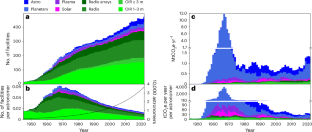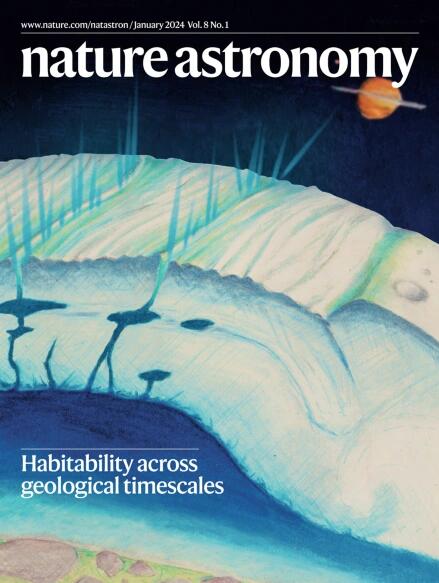Scenarios of future annual carbon footprints of astronomical research infrastructures
IF 12.9
1区 物理与天体物理
Q1 ASTRONOMY & ASTROPHYSICS
引用次数: 0
Abstract
Research infrastructures have been identified as an important source of greenhouse gas emissions of astronomical research. Based on a comprehensive inventory of 1,211 ground-based observatories and space missions, we assessed the evolution of the number of astronomical facilities and their carbon footprint from 1945 to 2022. We found that space missions dominate greenhouse gas emissions in astronomy, showing an important peak at the end of the 1960s, followed by a decrease that has turned again into a rise over the last decade. Extrapolating past trends, we predict that greenhouse gas emissions from astronomical facilities will experience no strong decline in the future, and may even rise substantially, unless research practices are changed. We demonstrate that a continuing growth in the number of operating astronomical facilities is not environmentally sustainable. These findings should motivate the astronomical community to reflect about the necessary evolutions that would put astronomical research on a sustainable path. A comprehensive inventory of the carbon footprints of 1,211 ground-based astronomical observatories and space missions over a period of 78 years is used to model the expected future annual carbon footprint from astronomical research infrastructures.


天文研究基础设施未来每年碳足迹的设想方案
研究基础设施被认为是天文研究温室气体排放的一个重要来源。基于对 1,211 个地面观测站和太空任务的全面盘点,我们评估了 1945 年至 2022 年期间天文设施数量及其碳足迹的演变情况。我们发现,太空任务在天文学的温室气体排放中占主导地位,在 20 世纪 60 年代末达到一个重要的峰值,随后有所下降,而在过去十年中又转为上升。根据过去的趋势推断,我们预测,除非改变研究方法,否则天文设施的温室气体排放量在未来不会出现大幅下降,甚至可能大幅上升。我们证明,运行中的天文设施数量的持续增长在环境上是不可持续的。这些发现应促使天文学界思考必要的变革,使天文学研究走上可持续发展的道路。
本文章由计算机程序翻译,如有差异,请以英文原文为准。
求助全文
约1分钟内获得全文
求助全文
来源期刊

Nature Astronomy
Physics and Astronomy-Astronomy and Astrophysics
CiteScore
19.50
自引率
2.80%
发文量
252
期刊介绍:
Nature Astronomy, the oldest science, has played a significant role in the history of Nature. Throughout the years, pioneering discoveries such as the first quasar, exoplanet, and understanding of spiral nebulae have been reported in the journal. With the introduction of Nature Astronomy, the field now receives expanded coverage, welcoming research in astronomy, astrophysics, and planetary science. The primary objective is to encourage closer collaboration among researchers in these related areas.
Similar to other journals under the Nature brand, Nature Astronomy boasts a devoted team of professional editors, ensuring fairness and rigorous peer-review processes. The journal maintains high standards in copy-editing and production, ensuring timely publication and editorial independence.
In addition to original research, Nature Astronomy publishes a wide range of content, including Comments, Reviews, News and Views, Features, and Correspondence. This diverse collection covers various disciplines within astronomy and includes contributions from a diverse range of voices.
 求助内容:
求助内容: 应助结果提醒方式:
应助结果提醒方式:


